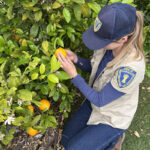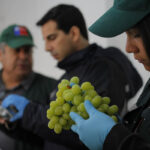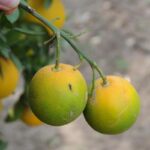APHIS Updates the Quarantined Areas for Sweet Orange Scab in California

Press Release (APHIS)
Effective immediately, the Animal and Plant Health Inspection Service (APHIS) is expanding the quarantined area for Elsinoë australis, the fungal causal agent of sweet orange scab (SOS) in California, revising the conditions for the interstate movement of citrus nursery stock (CNS) and citrus fruit from sweet orange scab (SOS) quarantined areas, and updating the definitions section of the Federal Order.
This Federal Order supersedes Federal Orders DA-2022-18 and DA-2021-35. This Federal Order also updates the “APHIS-Approved Packing House Procedures for Elsinoë australis, Causal Agent of Sweet Orange Scab (SOS)” that is maintained on the APHIS sweet orange scab webpage.
Specifically, this Federal Order establishes and expands the quarantined areas in California for SOS to align with the state interior quarantine that the California Department of Agriculture (CDFA) implemented in October 1, 2023 (3 CCR § 3443). It adds portions of Imperial, Los Angeles, Orange, Riverside, and San Bernardino Counties in California to the list of quarantined areas for SOS.
The quarantined area will include approximately 85 square miles in the Pomona area of Los Angeles and San Bernardino Counties, which includes 14 acres of commercial citrus; 136 square miles in the Calipatria area of Imperial County, which includes 2,685 acres of commercial citrus; 164 square miles in the San Gabriel and Whittier areas of Los Angeles Counties, which does not include any commercial citrus; 164 square miles in the Santa Ana area of Orange County, which includes 34 acres of commercial citrus; 95 square miles in the Riverside area of Riverside County, which includes 1,457 acres of commercial citrus; 81 square miles in the Winterhaven area of Imperial County, which includes 3 acres of commercial citrus; and 149 square miles in the Blythe area of Riverside County, which includes 684 acres of commercial citrus. This action is necessary to prevent the spread of SOS to non-infested areas of the United States.
In 2024, APHIS reviewed the results from thousands of inspections completed by both federal and state inspectors at facilities operating within an SOS-quarantined area and under an APHIS compliance agreement since SOS was detected in 2010. APHIS found no instance where SOS was detected in these facilities.
Based on this review, APHIS is removing two conditions that were included in Federal Order DA-2022-18 for interstate movement of CNS to commercial citrus-producing areas. These are: that the structure of the facility containing the CNS must have a solid roof/barrier and the CNS must not be exposed to overhead irrigation. This change will align with the requirements outlined in the Citrus Nursery Stock Protocol.
Accordingly, this change modifies the requirement for an SOS program-approved structure to an APHIS-approved structure.
In 2023, APHIS published final rule APHIS-2023-0007 to include Alabama in the list of commercial citrus-producing areas. Accordingly, we are updating the definition of a commercial citrus-producing area in the definitions section of this Federal Order to align with the final rule.
APHIS is also updating the APHIS-Approved Packing House Procedures for SOS. APHIS is removing the requirement that regulated fruit must be treated with imazalil and/or thiabendazole at the time of packing to move fruit interstate outside an SOS quarantined area, and instead requires that regulated fruit must be treated with an EPA-approved post-harvest fungicide labeled for use in citrus at the time of packing. This amendment provides producers with access to additional fungicide options while sufficiently mitigating the risk of disseminating SOS to areas outside the quarantined areas through the movement of fruit.
The attached Federal Order outlines the requirements for the interstate movement of CNS and citrus fruit from SOS quarantined areas, and includes the amendments described and provides the updated quarantined areas in California. State agricultural authorities may prescribe additional safeguards and protocols.
A description of all current SOS quarantined areas, Federal Orders, and other supporting regulatory documents may be found on the APHIS sweet orange scab webpage.









































